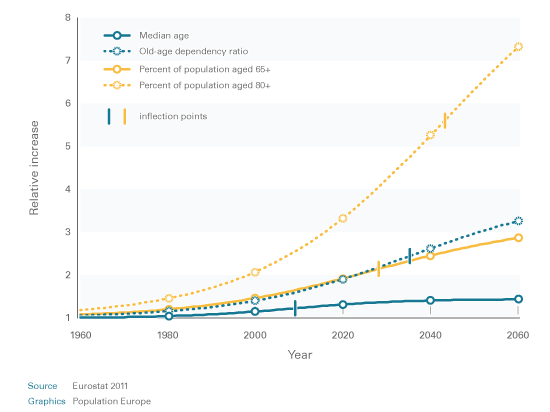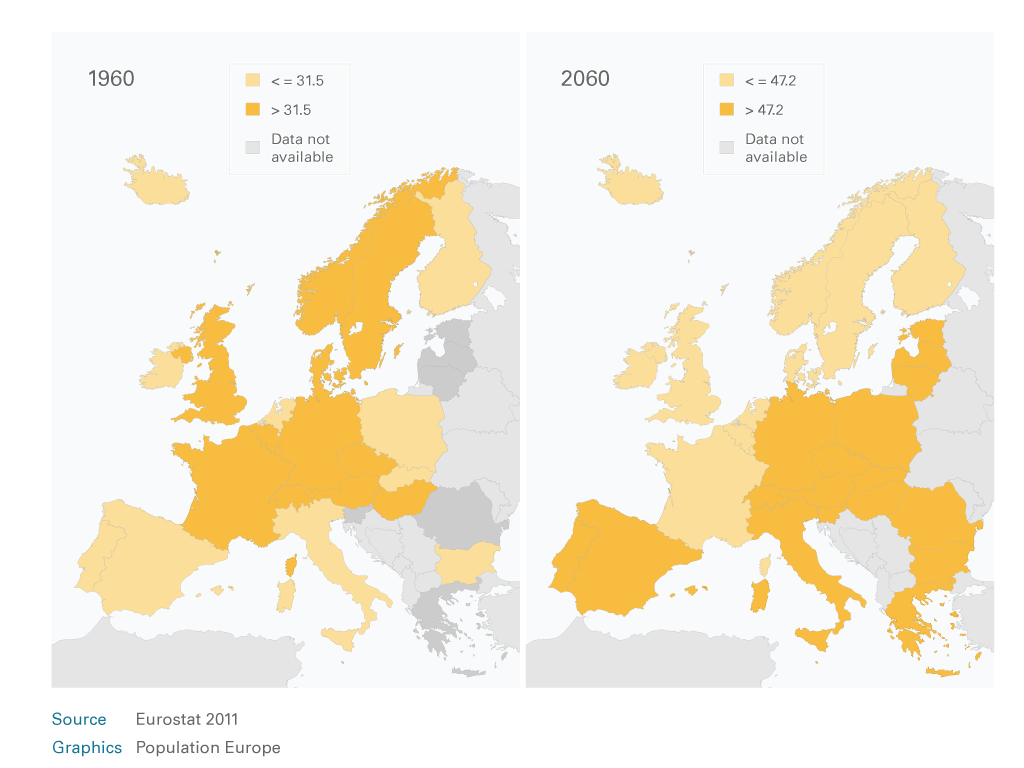The populations of all European countries are ageing but with substantial differences in magnitude, speed and timing. Building upon Eurostat projections from 2010 Giampaolo Lanzieri, head of Eurostats Section Demography, Census and Projections, elucidates cross-country differences within Europe. The author concludes that while some Nordic and Western European countries may have already experienced the climax of the ageing process, others, mainly situated in Southern and Eastern Europe, may soon need to deal with the consequences of the rapidly increasing proportion of older people.
Europe in the period from 1960 to 2060
In order to study the ageing process in Europe between 1960 and 2060, a period seen as the life span of the so-called baby boom cohort, Lanzieri employs four ageing indicators. These are median age, proportion of people aged 65 and over, proportion of people aged 80 and over, and old age dependency ratio (OADR).
In general, all indicators increased between 1960 and 2010 and are projected to continue growing and to reach unprecedented values in the next fifty years. There are, however, timing and pace differences. For example, while the median age may already have started to decelerate in some Nordic and Western European countries, the proportion of oldest old is likely to keep growing at a high pace in almost all European states in the next thirty years (see Figure 1).

Figure 1: Logistic lines of the relative increases in all countries’ averages of selected ageing indicators (base year 1960, inflection points: the moment when acceleration switches to deceleration)
It is projected that by 2060 most European countries will have a proportion of people aged 80 and over of about 10 percent, which is an increase by a factor of 9 when compared to the 1-2 percent proportion of oldest old at the beginning of the studied period. This is why the author suggests that “we are maybe in for a grandparent boom”, an argument that he grounds in the projected change of the ratio of young to old from 3:1 in 1960 to 1:2 in 2060. Europeans will likely have fewer siblings and cousins than grandparents, a shift that is known as a verticalisation of the family kinship structure.
From northwest to southeast
The three countries with the oldest populations in 2010, if all four indicators are considered together, were Italy, Germany, and Sweden. Yet, while Italy, for instance, recorded the highest European median age first at the beginning of the 21st century, Sweden took a leading position in the 1960s and the 1970s. Germany, on the other hand, reached the highest median age in Europe in the 1980s and it is projected to remain on top in the following three decades.

Figure 2: Countries above or below the average of the median age in 1960 and 2060
The European picture is quite likely to change after 2040, when Latvia and Romania are expected to have the highest median age while Sweden may have one of the youngest populations. This indicates a geographical shift from northwest to southeast (see Figure 2). The same spatial pattern can be seen when considering the other three ageing indicators. For example, the highest pace of increase of the OADR was first observed in most of the Northern European countries, then in some of the Western European countries and is predicted to be recorded in Eastern Europe towards the end of the studied period. If all indicators but the median age are combined, Germany, Poland, Romania and Slovakia are expected to be among those countries which may need to deal with a rapid ageing process the soonest.
High speed of ageing means less time for socio-economic adjustments
Lanzieri argues that the increase in speed is a particularly important issue for policy makers because it leaves less time for designing and implementing policies meant to cushion the negative consequences of population ageing. The author, furthermore, exhorts policy makers from the countries that may face a rapid increase in the proportion of older people to learn from countries that have already experienced the highest magnitude of ageing and are very likely to move towards having younger populations again.
This PopDigest is also available in French, Spanish and German.
This volume has been published with financial support of the European Union in the framework of Population Europe.